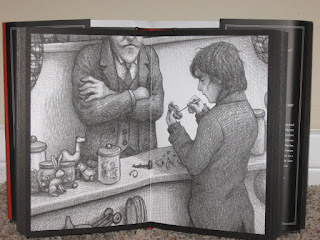Wednesday, June 6, 2012
The Magic of a Good Story--The Invention of Hugo Cabret
One of the reasons children (and adults!) are encouraged to read is that stories take the reader to other worlds. Escapism. Exploration. It is a gift to readers when an author can truly help you leave your present reality and live in the pages of a good book. I am reading a book that does this in a magical way.
I love innovation in the arts. I've always loved three-dimensional art, movies that do something new, and even books that create an experience that is unique. (This is one of the reasons I loved The Book Thief--see the post on May 10.) Perhaps you saw the movie Hugo. It was a visual and storytelling treat. Scorsese was able to direct such a beautiful visual experience because of the uniqueness of Brian Seltznick's illustrative genius in the book, The Invention of Hugo Cabret.
Here are some of the unique elements of Seltznick's book:
1. The pages are black, not white. This gives a feel that I've never had while reading before. Much of the book takes place at night or in the clock towers, so it is appropriate that black should be the background. The mood-making is perfect. The black pulls you in and causes the reader to see the book differently than typical white pages would.
2. Most of the story is told through illustration. To say that Seltznick is an illustrator is almost minimizing his incredible talent. There should be a word for artists who can draw like paintings. It is such a remarkable gift. Reading the pages of this book is like slowly watching a movie--Seltznick will draw four or five illustrations of the same scene, bringing the reader in closer with each frame. It is very personal and makes the reading an experience. I find that I "read" the illustrations slowly, so as not to miss any details. The author will tell four or five pages of story through 2-page spreads of illustration, then two to four pages of text. The written story is wonderful, but the illustration is what pulls the reader in.
3. Unlike most illustrated stories, The Invention of Hugo Cabret is told exclusively with black and white illustrations. I'm sure part of the reason Seltznick did this was because he was telling a story of early film and was reflecting that black and white motif. It also truly showcases his style of line pencil drawing.
Every year the Association for Library Services to Children chooses a book to honor with the Caldecott Medal, awarded for outstanding illustrations. The honored book each year is usually a picture book--they are the ones filled with illustrations! Hugo, however, is a middle reader book (7-12 year olds), with a more complex story that will appeal to children beyond the picture-book stage. Brian Seltznick won the Caldecott Medal in 2008 for The Invention of Hugo Cabret, and if you read it, you will most certainly understand why. Pin It
Subscribe to:
Comments (Atom)

